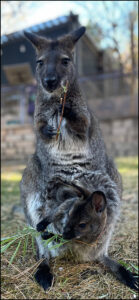In July, we told you about the new shipping container farm growing produce for animals at Cheyenne Mountain Zoo. Since then, CMZoo’s horticulture team has been working through challenges and growing their knowledge, along with lots of lettuce.
Last month, they harvested their first test yield of romaine lettuce for CMZoo’s giraffe herd! “They ate it up!,” said Denny Patton, senior horticulturist at CMZoo. “After so many months of trial and error, testing, failing, and trying again, it was really cool to see the animals enjoying this produce that we’ve worked so hard to provide.”
As every Colorado gardener knows, farming in The Centennial State is no easy feat. Using a complex, year-round growing system like this one requires commitment, patience, and ongoing education. “We’re learning so much,” said Patton. “I don’t think any of us thought we’d be programming computers and testing water’s oxygen levels in this role. We love this project. It’s a challenging and rewarding adventure.”
It’s hard to find a project much greener than this. The system is energy-, water- and space-efficient. Because the growing system’s shell was a freezer shipping container in its previous life, it’s heavily insulated. That will protect the plants from Colorado’s extreme temperature ranges, and allow the team to grow produce year-round.
The hydroponic lettuce growing system inside the container is one of the most efficient ways to grow lettuce – and as anyone who has visited our 17-member giraffe herd knows, they go through a lot of lettuce. On average, the Zoo uses more than 3,500 heads of romaine lettuce per month. Romaine lettuce is a small part of the giraffes’ diet, but it’s a huge part of our guests’ experience. The long-term goal is to grow about 55% of the Zoo’s lettuce using systems like this one, by expanding the number of shipping container farms at the Zoo.
The team is learning through trial and error. They’re testing how often they need to replace the water in the hydration tanks, which kinds of seeds grow well, how the automatic climate controls work (and don’t!), and how they could potentially improve growing conditions by altering the climate and nutrients in the system depending on the plant’s stage of development. That’s down the line, though, and only if this testing phase is deemed successful.
“Right now, we can grow about 2,500 plants at a time,” said Patton. “We’re testing how to make this as energy-efficient and water-conservative as possible. We’re even looking into different grow racks because we might be able to double the number of plants we can grow at once by shuffling around some of the shelving.”
The single shipping container farm should produce about an acre’s worth of lettuce using only 40 gallons of water per day. The system also uses a dehumidifier to capture excess water from the air and filter it back into the watering reservoirs. The ebb-and-flow hydroponic system uses less than a typical shower to fuel hundreds of heads of lettuce.
“We’re planting on a weekly schedule,” said Patton. “On any given week, you’ll see brand-new seedlings, growing heads of lettuce, and mature lettuce, ready to be fed to our animals. It’s a constant cycle, which we hope will eventually reduce the Zoo’s dependence on outside food sources.”
The team’s commitment to mastering this art-and-science project is paying off. They’re producing about 230 heads of lettuce a week – that’s between 30 and 50 pounds – for CMZoo’s animals, at a 90 percent success rate. Having nailed down a successful growing plan for romaine lettuce, the team is expanding the menu. They are also growing kale, which was a treat for our orangutans recently.
“The orangutans’ keepers said they didn’t usually eat the store-bought kale, but they gobbled our Zoo-grown kale right up,” said Patton. “I don’t think there’s a better compliment than that.”
Lettuce and kale aren’t the only things growing – much to our animals’ delight. “Browse is a huge part of our animals’ diets, but its availability is limited in our state – especially in the winter months,” said Patton. “When you come and peek through the shipping container’s window, you’ll see some tiny sticks in there. We’re attempting to grow our own tree branches and leaves through propagation. We did a batch of native coyote willow for our wallabies, and they loved it!”
The horticulture team will continue testing the efficiency of the growing system, and sharing the fruits of their labor with CMZoo’s animals. Guests are welcome to check out the project, next to the carousel, on their next visit.










